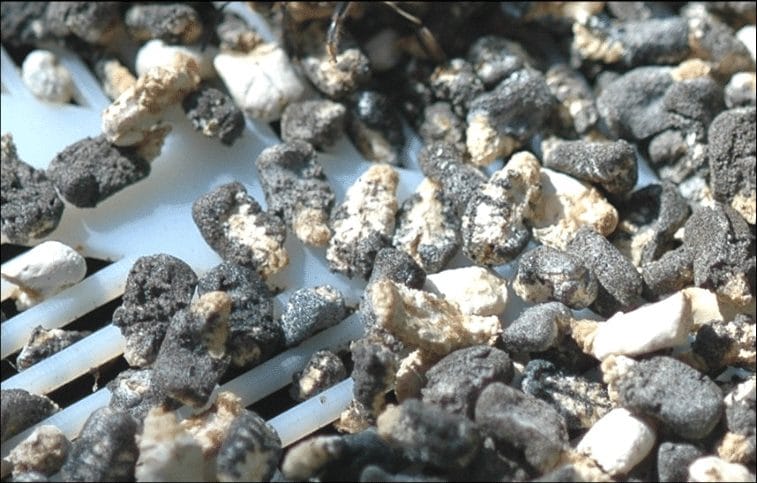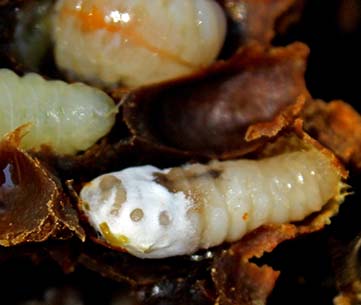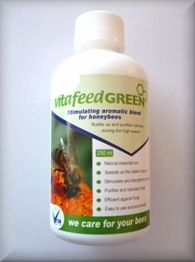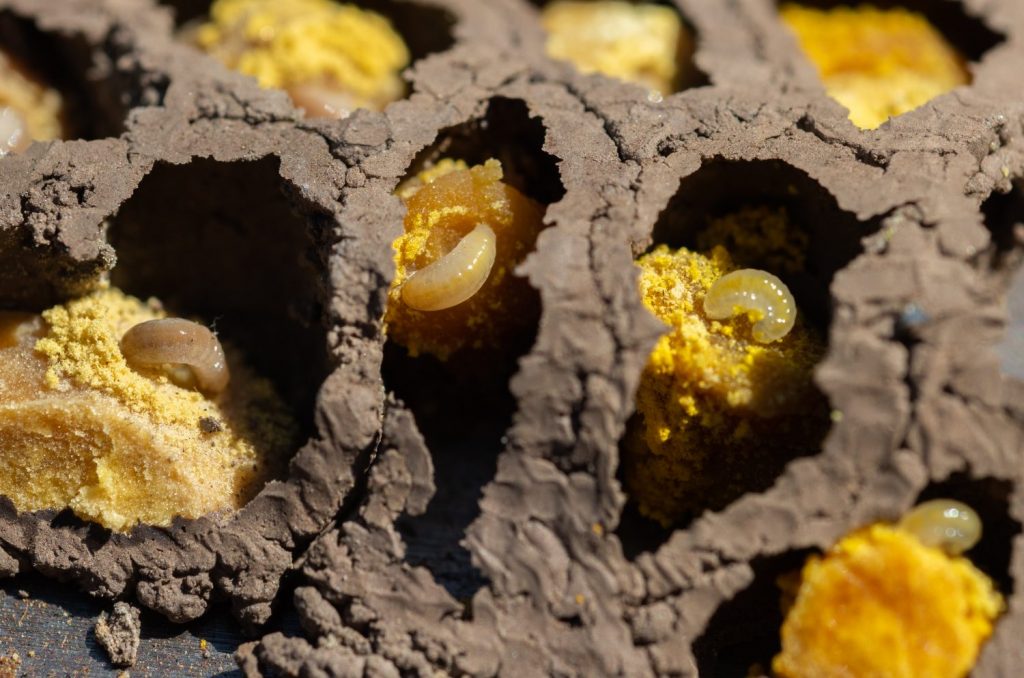If you purchase an independently reviewed item through our site, we earn an affiliate commission. Read our affiliate disclosure.
Quick Overview
Chalkbrood disease, caused by the fungus Ascosphaera apis, is a significant affliction of honey and mason bees, leading to mummified larvae within the hive. Chalkbrood can affect both sealed and unsealed brood, with the larvae becoming hard and white, resembling chalk. The disease is highly infectious, with spores capable of remaining viable for up to fifteen years, posing a risk of cross-colony contamination.
Environmental stressors such as extreme weather and hive stress can predispose bees to chalkbrood. Symptoms include a spotty brood pattern and the presence of mummified larvae at the hive entrance. Diagnosis is typically straightforward, with visible signs like white mummified larvae and punctured cell caps, but can be confirmed through laboratory testing.
Transmission occurs through contaminated pollen and can be spread by foraging bees, infected equipment, and even newly introduced queens. Treatment focuses on good management practices, such as maintaining hive hygiene, proper ventilation, and adequate feeding to ensure strong colony health. The use of disease-resistant bees can also limit the spread of chalkbrood.
Chemical treatments include essential oil-based products like BeeVital Chalkbrood and Vitafeed Green, which help improve bee health and combat the fungus. Thymol oil, used against Varroa mites, can also be effective. For mason bees, hygiene, and sanitation are crucial, with recommendations to harvest mature cocoons to prevent larvae infection.
While chalkbrood is a serious threat to bee colonies, effective management and treatment strategies can control its spread, ensuring the health of honey and mason bees, which are vital for pollination and agriculture.
About Chalkbrood Disease
A major affliction of honey and mason bees is the chalkbrood disease, which is caused by the fungus Ascosphaera Apis. The disease affects honeybee colonies the world over. It mummifies the larvae of honeybees, leaving larvae in bee brood cells hard on the outside and white on the inside. The mummified larvae look like a piece of chalk, hence the name chalkbrood. This disease of honeybees affects both sealed and unsealed brood in a colony. These mycelia multiply and eventually engulf the entire larvae inside the cell and kill it. This guide helps you with chalkbrood disease treatment for honey and mason bees.
In a chalkbrood infection, the affected larvae eventually take the appearance of white fluffy cotton wool. The fungal spores of Ascosphaera Apis are highly infectious and can persist for fifteen years in a viable state. In this state, they (fungal spores) are able to infect other colonies should they come in contact with them.
The disease can sometimes appear where antibiotics have been used for other preventative treatments. Other factors are the alkalinity (the pH) of nectar or artificial food, humidity, and lack of ventilation in the hive.
Predisposing Factors to Chalkbrood Disease
Certain factors and conditions, if present in a beehive will predispose the colony to a chalkbrood disease outbreak, especially if the fungi is present but latent. Such factors include weather and stress.
1. Extreme Weather
Extreme weather conditions are a predisposing factor in the emergence and persistence of chalkbrood. A change in the brood-nest temperature can trigger chalkbrood disease. Adverse weather conditions will make nurse bees cluster together, leaving the brood unattended. If the weather is too hot, heat fanning will take precedence leaving the brood again unattended. Usually, the first larvae affected are those around the edges of the brood, where the brood temperature may be higher or lower.
2. Stress
Stress is a predisposing factor to fungal attack, as bees cope with the stress by leaving the broods unattended. When honeybees get stressed, this gives the fungi a chance to thrive, and this will be followed by the emergence of the fungi that will thrive and cause a lot of damage to the colony. Any activity that can cause stress to a colony, must therefore be avoided as a check against chalkbrood infestation.
Common causes of stress include poor health and nutrition, extreme weather (high and low temperatures and wet and dry conditions), any disease attack, a failing queen, disturbances such as moving hives frequently, and poor hive hygiene.
Symptoms of Chalkbrood Disease

It is much easier to observe chalkbrood disease symptoms during the spring. However, it is also possible to observe the symptoms in all other seasons.
The most prominent symptom of this disease is the spotty brood pattern in heavy infestations. One cannot possibly mistake the fluffy cotton appearance of the larvae. The most obvious symptoms of an attack by this disease are:
- A spotty brood pattern;
- Chalk-like mummies in open brood;
- Chalk-like mummies at the colony entrance.
The first indication of an attack is seen when larvae become covered with a fluffy white fungal (mycelial) growth that looks like white mold on bread or very fine cotton wool. Then the larvae swell to fill the cell, later becoming dry and hard and take the characteristic white or grey/black chalk-like mummy appearance, hence the name.
When the adult worker bees detect the dead larvae inside their capped cells, they will try to poke holes through the caps to try and remove them. Empty cells with holes chewed through them through the caps are another indication of the disease. The white chalk-like mummies will be removed from their cells within ten days and will be dropped onto the hive floor and later, outside the entrance of the hive where they can be observed easily. Though the bees often pull out the dead larvae and dispose of them, if the chalkbrood is prolific enough, it can often be too much for bees to cope with.
Diagnosis of Chalkbrood Disease
The sure way of diagnosing the chalkbrood infection is a laboratory testing of the fungus. However, in most cases, this is not necessary as it is easy enough to observe the dead larvae remains on the hive floor, or at the entrance to the hive where they are dropped once removed from the cells. Dead larvae will shrink and dry to form white or grey-black chalk-like mummies. In addition, there are holes in the cell cappings which are cut by worker bees when retrieving the mummies to discard them). These discarded mummies can be found near the hive entrance of infected colonies.
Transmission of Chalkbrood Disease
Chalkbrood disease can be transmitted in a number of ways. Foraging bees, if they are infected, will carry the fungus in contaminated pollen and leave it wherever they land including on floral and water sites. If they should get into another hive, they will also leave the fungus there to infect more bees. Queen bees if introduced into other hives, will carry the fungus and the disease there too.
Infected worker bees contaminate brood food during feeding, as the spores carrying the disease get mixed with pollen feed. The fungus then feeds on the same food as the larvae but will promptly out-compete larvae for the food. The larvae will eventually die with their corpses taking a “chalk-like” mummy look.
The longevity of the spores in viable form makes the disease a very dangerous thing because this offers it a good medium to spread. Tools and other implements used to work on infected hives will also transmit other hives.
How to Treat Chalkbrood Disease in a Honeybee Colony
Both good management practices and the use of some chemicals can be effective against the fungi. There are various chemicals mostly based on essential oils, made to control infestations in colonies. In most cases, the general weakness of the bees in a colony renders them more susceptible to attacks from all manner of pests and diseases. Thus, maintaining healthy bees and feeding them well is recommended to ward off many attacks. Other than chemicals, practicing good hive management is important to reduce attacks from mites, fungi, and even bacteria. The use of disease-resistant bees will limit the spread of the disease.
It is of note that some studies carried out in some apiaries, have shown that thymol-based medications show some significant effect on chalkbrood disease infestations.
1. Good Management Practices
As the chalkbrood fungi is transmitted via spores, good hygiene practices can limit the spread. For instance, it is important to ensure that work clothes are properly disinfected, as are smokers and tools and other equipment used to work hives. This limits the spread of the spores from one colony to another through contaminated tools and equipment.
It has been observed that any activity that results in stressing a colony, makes it more susceptible to an attack by this fungus. As such, management practices that reduce the stress on hives also reduce the number of chalkbrood spores. I advise beekeepers to maintain strong healthy colonies as this has been demonstrated to reduce the severity of chalkbrood disease in a colony. Such management practices include:
Cleaning the hive
It is important to clean the hive by removing all the dead larvae mummies from both the bottom and the entrance where they are dropped after being removed from the cells. This is a primary activity that will also get rid of many other pests that could invade the hive. As this effort is going on, the beekeeper should also remove and destroy all the combs containing the dead larvae and, if necessary, supply new combs free from the fungus.
Ensuring the hive is well-ventilated
A well-ventilated hive ensures good bee health. As such, the beekeeper should ensure that there is adequate ventilation.
Feeding
To insure bees against hard times such as during winter or when forage is inadequate to provide the necessary nectar, beekeepers should feed their bees on sugar syrup, and fresh pollen that is uncontaminated and if possible use other supplements. This ensures a healthy well-fed colony that is able to fight off the chalkbrood and other infestations.
No equipment interchange
The beekeeper must ensure that there is little or no interchange of hive materials, so as to avoid cross-contamination.
2. Use of Disease-Resistant Bees
It has been noticed in many parts of the world that some honeybee colonies are less affected by chalkbrood than others. This difference has been attributed to the ability of some bees to uncap and remove the dead larvae from their capped cells. By selecting queen bees or obtaining queen bees from hives that show resistance to this disease, the effects of chalkbrood can be reduced.
In summary, a combination of management practices that reduce stress and chalkbrood spores, maintaining strong and healthy hives, and using bees from colonies that show resistance to chalkbrood are recommended ways to reduce the chalkbrood infestation in a new colony.
We’ll now discuss chemical solutions to treat the chalkbrood disease.
3. BeeVital Chalkbrood
Beevital Chalkbrood is an organic mixture that inhibits the growth of the chalkbrood fungus and helps to eliminate the affected brood, encouraging the bees to remove the mummified larvae.
This treatment should be used in the spring and autumn but you can intervene at any time without tainting or damaging honey during the flow. You apply the mixture directly from the bottle between the infected brood frames, using approximately 20ml-30ml per colony. The treatment is repeated two to three times at 7-10 day intervals.
This product is best used with a ventilated floor and roof to prevent humidity. Good beekeeping husbandry is essential, so make sure you also wash and clean your equipment regularly.
4. Vitafeed Green
Vitafeed Green is a liquid extract made from essential oils of walnut, marjoram and thyme. It is designed to help improve bee health and stimulate colony development. A healthy and strong colony is shown to ward off fungi, as the bees are able to deal with the environmental changes (ventilation and heat generation) as necessary. It has been shown that a weak colony is much less resistant to fungal attack, as the bees’ ability to ventilate the hive is greatly reduced. Fungi grow best in humid and poorly ventilated environments.
The liquid feed also stabilizes the pH of the bee gut to within the optimum range of 6.3 to 6.6. This is important, as it offers wide-spectrum protection against harmful bacteria and fungi.
Vitafeed green has antioxidant properties. This property gives it a significant effect against both Varroa mites and the fungi causing chalkbrood disease. Its use has been shown to reduce the infestation of the fungi responsible for transmitting chalkbrood.
Vitafeed Green can be used at any time of year but is usually most effective either in early spring to stimulate colony development, or in autumn to help prepare bees for winter. One liter of Vitafeed Green is enough to treat twenty (20) beehives, best applied in one dose, mixed with sugar syrup.
Being a “green” product-made from natural extracts, Vitafeed Green leaves no residual and has no negative effect on bees.
5. Thymol Oil
Thyme oil an essential oil extracted from the thyme plant which commonly used against Varroa mites. The Varroa mite is thought to influence the growth of chalkbrood causing fungi, as the mites are responsible for weakening a colony, rendering it more susceptible to the fungi as the bees become too weak to fight the fungal attack. Thyme oil is commonly applied as a fumigant. When applied as fumigants, the effectiveness of thymol depends greatly on temperature, time of the year and colony strength.
Chalkbrood Disease and Mason Bees
According to the Department of Agriculture research services, chalkbrood is a very severe threat to mason bees. The population of mason bees (Osmia lignaria) is under threat and can be wiped out unless urgent measures are taken.
The precise working of the fungus in the genus Ascosphaera, that attacks the blue orchard mason bee is little known. In actual fact the actual fungus is unknown. However, the fungus is highly contagious and will easily wipe out a colony.
The fungus infects and kills the larvae when they ingest the spores containing the fungi. This is lethal and the larvae die showing the classic characteristics of the chalkbrood disease. Adult mason bees spread the fungus to flowers and other nesting sites when they come into contact with dead larvae.
The severity of Chalkbrood Disease to Mason Bees
Currently, more than half of all mason bee colonies in the United States show a varying degree of infestation with chalkbrood. The majority of the colonies show more than 50% infestation with the deadly disease.
To avert the possible wipeout, mason beekeepers are advised to redouble their efforts in maintaining hygiene and sanitation in their colonies as the first measure to control the spread. Cleaning and sanitizing all nesting sites and homes on a yearly basis is recommended.
To prevent already formed larvae from getting infected and dying, mason beekeepers should proceed and harvest all mature cocoons and preserve them appropriately until they turn into adults. Harvesting cocoons and shepherding them to maturity is a complicated process though, and one needs to get all the information concerning this before making the attempt. That said, saving mason bees is well worth the time and effort it takes to do it right.
Major Beekeeper Considerations in Chalkbrood Disease Management
As we’ve discussed, the chalkbrood disease is caused by the fungus Ascosphaera Apis. The disease primarily attacks bee brood. The fungus is in larvae cells when nurse bees feed the larvae. The fungus competes for food with the larvae eventfully killing them. An attack by this disease is likely to decimate the bee population as no larvae will mature into adult bees.
There are many predisposing factors that an attack and beekeepers should be aware of these factors. Reducing the incidence of these predisposing factors reduces the chances of the fungus growing. Beekeepers should learn to avoid any activity that will stress the colony, as a stressed colony is less able to resist the fungus. There are several control measures that beekeepers can adopt in an attempt to reduce the incidence of the disease in their colonies. Good management practices such as maintaining good hygiene of the hive, avoidance of stressing the bees, and ensuring that they are strong and well-fed, are the first line of defense against the disease.
There are various organic preparations that have some effect in tackling the fungi in a bee colony. For instance, the use of thyme oil, an essential oil is seen as effective against chalkbrood disease. Beevital chalkbrood is yet another substance that has some appreciable effect on the fungi. Perhaps, the best of these preparations, though not a silver bullet to the disease, is another organic preparation referred to as Vitagreen. This substance is made from natural ingredients and leaves no residue when used on bees. As a feed, it gives strength to bees and boosts their immune system, making them more able to resist an attack.
Chalkbrood disease is a serious threat to mason bees too, and currently, few if any mason bee colonies are free from the fungus. Beekeepers are urged to take the necessary measures to control infestation and save the mason bees under their keep from complete decimation.
Effects of Chalkbrood Disease in Beekeeping
The beekeeping industry has continued to expand worldwide with more bee products being added to the menu of outputs from the sector. Starting as a traditional art in many parts of the world, it has turned commercial with hundreds of apiaries opening up every other day.
Traditional beekeeping has been overtaken by commercial operations with tons of honey, beeswax, propolis, bee venom, and many other products. However, a myriad of diseases and pests have become a threat and unless checked, there is the danger of wiping out large colonies of honeybees with the consequent reduction of output of these products.
Beekeepers would lose a lot, being a beneficiary of healthy bee colonies that are key pollinators for many commercial agricultural plants the world over. The beekeeping industry needs protection from these pests and diseases such as chalkbrood by all means. This would naturally start by identifying these pests and diseases and looking for means to control them. This is an ongoing process with research taking place in institutions all over the world.
Conclusion
As there are so many threats to bee colonies, including chalkbrood disease, beekeepers are urged to get all the information they can on apiary operations. Such information is freely available from the United States Department of Agriculture, bee research institutions, farmers’ clubs, and other publications on bees. Unless checked, chalkbrood will continue to threaten honeybee colonies and reduce the earnings from the entire industry. You can go to your nearby beekeeping clubs to share tips on how they go about chalkbrood disease treatment for honey and mason bees.
References
- https://www.honeybeesuite.com/chalkbrood-disease-of-honey-bees/
- https://edis.ifas.ufl.edu/publication/AA138
- https://hivealivebees.com/bee-health/chalkbrood
- https://nationalbeeunit.com/downloadDocument.cfm?id=1391
- https://academic.oup.com/jee/article/105/6/1878/789393
- https://www.mda.state.mn.us/chalkbrood-disease
- https://www.hgsc.bcm.edu/sites/default/files/images/review_Chalkb.pdf
Has your beehives ever been afflicted by chalkbrood disease? Leave a comment below and let us know what your experience was like.
 BeeKeepClub Resources and Guides for Beekeepers
BeeKeepClub Resources and Guides for Beekeepers




